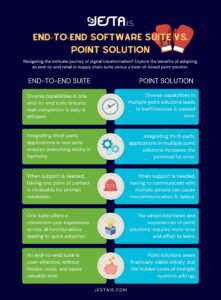by Jesta I.S. | February 16, 2024
Retail leaders, including IT professionals, are always in search of software solutions that meet their functional needs and offer unparalleled convenience. As they consider the myriad of options available, the decision often boils down to adopting an end-to-end software suite or opting for a best-of-breed point solution. Here, we explore the benefits of these two approaches, particularly in terms of convenience.
1. A Symphony of Capabilities
End-to-end suites bring the convenience of managing diverse capabilities from a singular system. The wealth of operations reduces the complexities IT leaders face, eliminating the need to shuffle between disparate systems and ensuring efficiency remains at the forefront. The contrast with point solutions is stark, where the disjointed nature can often lead to inefficiencies and increased management overhead.
2. Seamless Integration & Scalability
Integration is the linchpin of convenience. An end-to-end suite is designed to ensure that every component works in harmony, creating a seamless and cohesive user experience. This eliminates the arduous task for IT leaders of integrating multiple point solutions, which may not always align with saving time, resources, and mitigating the risk of integration failures.
What’s more, IT leaders can modify functionalities as the business evolves, without worrying about integration issues, a prevalent concern with point solutions. The ability of a suite to scale and adapt to the changing needs of an organization is a convenience that cannot be understated.
3. Streamlined Support
When support is needed, having a single point of contact is invaluable. End-to-end suites offer the simplicity of dealing with one vendor, ensuring that communication is streamlined, and issues are resolved promptly. This is a far cry from the multiple vendors and varied processes associated with point solutions, which can often lead to delays and complications.
4. Consistent User Experience
End-to-end suites offer a consistent user experience across all functionalities, fostering quick adoption and reducing the learning curve for end users. This uniformity is a significant advantage over the varied interfaces and experiences of point solutions, ensuring users can navigate through the system with ease and efficiency.
5. Cost and Time Effectiveness
While point solutions may seem economically viable initially, the hidden costs of managing, integrating, and maintaining multiple systems can escalate rapidly. An end-to-end suite emerges as a cost-effective alternative, providing comprehensive functionality without hidden costs, and saving valuable time for IT leaders to focus on strategic initiatives.
Building on a Solid Foundation: End-to-End Digital Transformation
Navigating the intricate journey of digital transformation, IT leaders stand at a pivotal juncture. Although point solutions may seem tempting, they often only serve as a band-aid, addressing individual department needs rather than facilitating true, enterprise-wide digital transformation.
In stark contrast, a comprehensive suite emerges as a cohesive and empowering solution for every business user department, offering a strategic balance between unified operations, seamless integration, cost-effectiveness, and scalability. The added ability to integrate select, third-party point solutions, backed by vendor support, further cements the end-to-end suite as the cornerstone of digital transformation, enabling IT leaders to truly shape the future of their organizations by ensuring stability and coherence, and fostering innovation.
Check out the End-to-End Software Suite vs. Point Solution infographic here.

